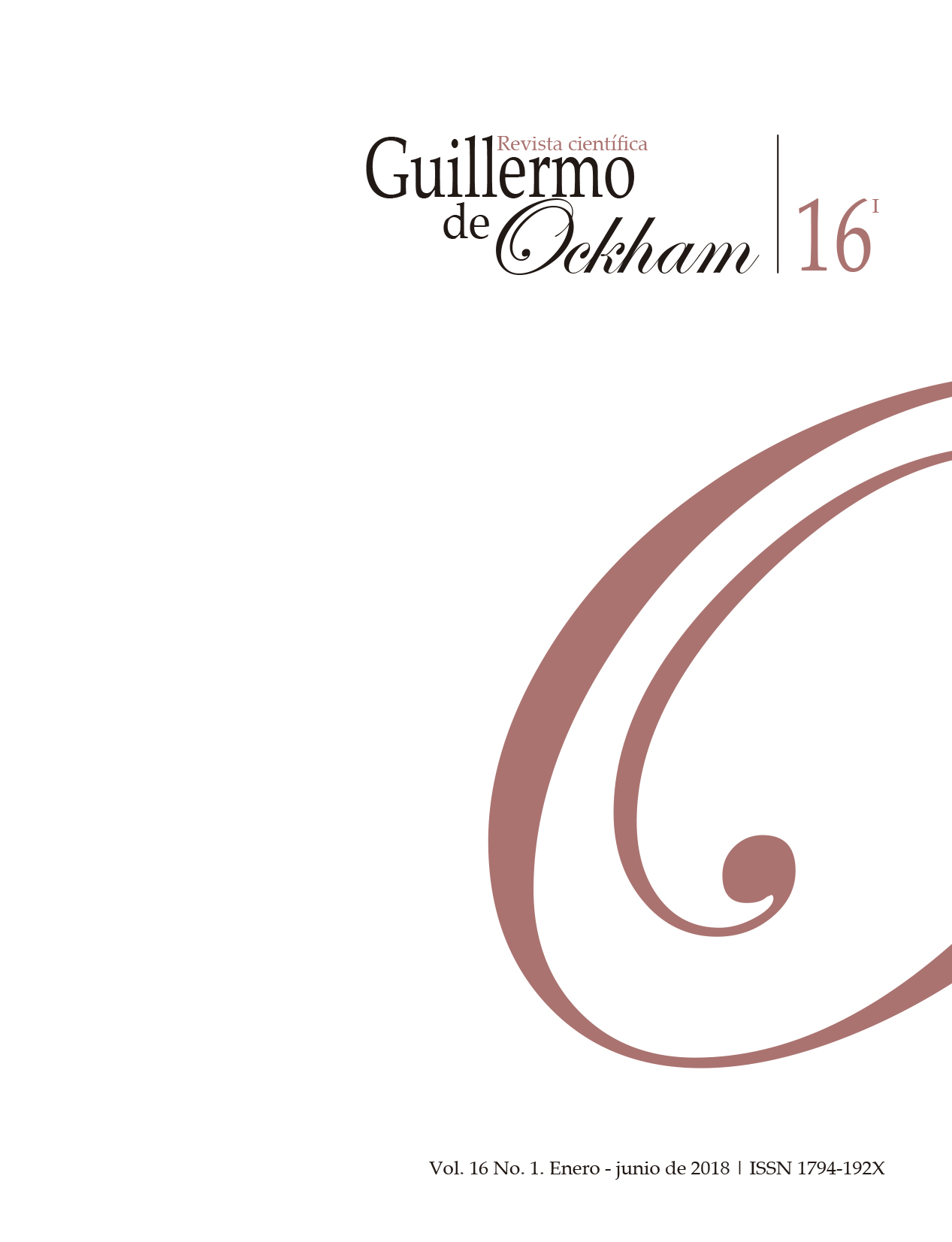La Revista Guillermo de Ockham brinda un acceso inmediato y abierto a su contenido, basado en el principio de ofrecer al público un acceso gratuito a las investigaciones para brindar un intercambio global de conocimiento. A menos que se establezca lo contrario, el contenido de esta revista tiene una licencia con Creative Commons Attribution-NonCommercial-NoDerivatives 4.0 International (CC BY-NC-ND 4.0) http://creativecommons.org/licenses/by-nc-nd/4.0/
- Atribución: debe otorgar el crédito correspondiente, proporcionar un enlace a la licencia e indicar si se realizaron cambios. Puede hacerlo de cualquier manera razonable, pero no de ninguna manera que sugiera que el licenciante lo respalda a usted o su uso.
- No comercial: no puede utilizar el material con fines comerciales.
- Sin derivados: si remezcla, transforma o construye sobre el material, no puede distribuir el material modificado.
- Sin restricciones adicionales: no puede aplicar términos legales o medidas tecnológicas que restrinjan legalmente a otros de hacer cualquier cosa que permita la licencia.
Resumen
The purpose of this study is to meet the motivations and psychological state of the popular runners, differentiating between federated and non-federated, and between men and women. The sample was composed of 473 popular runners, using Motivations of Marathoners Scales (MOMS) and CSAI-2R to evaluate motivation and anxiety. The results indicate that federated runners present higher scores in sense of life and lower scores in self-confidence, achievement of personal goal, self-esteem and recognition search. On the other hand, the men obtained significantly higher scores on physical fitness, social interaction and attraction to the competition, convenience and competition and lower scores on the meaning of life.
Palabras clave:
Citas
Barrios, R. (2001). Motivación hacia la práctica del ejercicio en corredores cubanos. EFDeportes.com, Revista Digital, http://www.efdeportes.com. Buenos Aires Año 6 - Nº 31. Feb/2001.
Barrios, R. y Cardozo, L. (2002). Motivación para competir en corredores populares cubanos. Disponible en http://www.efdeportes.com/efd47/motiv.htm (visitado el 15 octubre del 2012).
Donzelli,G.J., Dugoni, B.l. y Johnson, J.E. (1990). Competitive State and Competitive Trait Anxiety Differences in Non-Elite Runners / Difference d’anxieté de competition de caractere ou de situation chez des coureurs ne faisant pas partie de l’elite”, Journal of Sport Behavior, 13 (4), 255-266. Disponible en: http://psycnet.apa.org/record/1991-17100-001.
Jaenes, J. C. (2000). Estado emocional y conducta deportiva: Ansiedad competitiva en corredores de maratón. Tesis Doctoral. Universidad de Sevilla, Sevilla.
Jones, G., y Swain, A. (1995). Predisposition to experience debilitative and facilitative anxiety in elite and non-elite performers. The Sport Psychologist, 9, 201 211. Disponible en http://journals.humankinetics.com/tsp-back-issues/tspvolume9issue2june/predispositionstoexperiencedebilitativeandfacilitativeanxietyineliteandnoneliteperformers. DOI: https://doi.org/10.1123/tsp.9.2.201
Llopis, D., y Llopis, R. (2006). Razones para participar en carreras de resistencia. Un estudio con corredores aficionados. Cultura, Ciencia y Deporte, 2(4), 33- 44. Disponible en http://www.redalyc.org/pdf/1630/163017601005.pdf. DOI: http://dx.doi.org/10.12800/ccd.v2i4.168.
Lopez-Gullon, J. M., Torres-Bonete, M. D., Berengui, R., Diaz, A., Martinez Moreno, A., Morales, V. y Garcia-Pallares, J. (2012). Rendimiento físico y psicológico en lucha olímpica: predictores del éxito en lucha femenina. Anales de Psicología, 28(1), 215-222. Disponible en http://www.redalyc.org/pdf/167/16723161024.pdf
Martens, R., Vealey, R.S. y Burton, D. (Eds.) (1990). Competitive Anxiety in Sport. Champaign, Ill: Human Kinetics.
Masters, K.S., Ogles, B.M. y Jolton, J.A. (1993). The development of an instrument to measure motivation for marathon running: The Motivation of Marathoners Scales (MOMS). Research Quarterly for Exercise and Sport, 64, 134-143. DOI: 10.1080/02701367.1993.10608790.
McMillan, J. y Schumacher, S. (2005). Investigación Educativa. Madrid: Pearson.
Martinez-Abellan, A., Garcia-Pallares, J., Lopez-Gullon, J. M., Muriel, X., Morales, B. y Martinez-Moreno, A. (2010). Factores anaerobicos predictores del exito en lucha olimpica. Cuadernos de Psicología del Deporte, 10(2), 17-23. Disponible en: http://revistas.um.es/cpd/article/view/111221.
Ntoumanis, N., y Jones, G. (1998). Interpretation of competitive trait anxiety symptoms as a function of locus of control. International Journal of Sport Psychology, 29, 99–114. Disponible en: https://www.cabdirect.org/cabdirect/abstract/19991802127.
Núñez, F. J., Oña, A., Raya, A. y Bilbao, A. (2009). Differences between expert and novice soccer players when using movement precues to shoot a penalty kick. Perceptual and Motor Skills, 108, 139-148. Disponible en http://www.ncbi.nlm.nih.gov/pubmed/19425456
Ogles, B. M., Masters, K. S., y Richardson, S. A. (1995). Obligatory running and gender: an analysis of participative motives and training habits. International Journal of Sport Psychology, 26, 233-248.
Olmedilla, A., Ortega, E. y Abenza, L. (2007). Percepción de los futbolistas juveniles e influencia del trabajo psicológico en la relación entre variables psicológicas y lesiones. Cuadernos de Psicología del Deporte, 7(2), 75-87. Disponible en http://revistas.um.es/cpd/article/view/54611
Olmedilla, A., Andreu, M.D. y Blas, A. (2005). Variables psicológicas, categorías deportivas y lesiones en futbolistas jóvenes: un estudio correlacional. Analise Psicologica, 4(23), 449-459. Disponible en http://publicacoes.ispa.pt/index.php/ap/article/view/561. DOI: https://doi.org/10.14417/ap.561
Pozo, A. (2007). Intensidad y dirección de la ansiedad competitiva y expectativas de resultados en atletas y nadadores. Revista de Psicología del deporte, 16(2), 137-150. Disponible en: https://core.ac.uk/download/pdf/13295960.pdf.
Ponce de León, Y.; López, J., y Medina, M. (2006). Habilidades psicológicas en los atletas de primera fuerza en atletismo. Revista de Ciencias del Ejercicio –FOD-, 2(1), 42-57. Disponible en: http://www.scielo.org.co/pdf/rups/v13n3/v13n3a20.pdf. DOI: 10.11144/Javeriana.UPSY13-3.fdaa
Reina, R. (2004). Análisis del comportamiento visual y motor de reacción de jugadores de tenis y tenis en silla de ruedas en el resto al servicio. Tesis doctoral no publicada. Universidad de Extremadura.
Ruiz-Juan, F. y Zarauz, A. (2011). Validación de la versión española de las Motivations of Marathoners Scales (MOMS). Revista Latinoamericana de Psicología, 43(1), 139-156. Disponible en http://dialnet.unirioja.es/servlet/articulo?codigo=3619046. DOI: 10.14349/rlp.v43i1.629
Salinero, J. J.; Ruiz, G., y Sánchez, F. (2006). Orientación y clima motivacional, motivación de logro, atribución de éxito y diversión en un deporte individual. Apunts, 83, 5-11. Disponible en: https://www.raco.cat/index.php/ApuntsEFD/article/view/300628.
Scanlan, T. K.; Babkes, M. L., y Scanlan, L. A. (2005). Participation in sport: A developmental glimpse at emotion. En J. L. Mahoney, R. W. Larson y J. S. Eccles (Eds.). Organized activities as contexts of development: Extracurricular activities, after school, and community programs. (pp. 275-309). Mahwah, NJ: Erlbaum.
Smith, R. E.; Smoll, F. L., y Wiechman, S. (1998). Measurement of trait anxiety in sport. En J. L. Duda (Ed.), Advances in sport and exercise psychology measurement. Morgantown, WV: Fitness Information Technology.
Thomas, J.R. y Nelson, J.K. (2007). Métodos de investigación en actividad física. Barcelona: Paidotribo.
Verma, G. y Mallick, K. (1999). Researching Education. Perspectives and Techniques. London: Falmer Press.
Zarauz, A. y Ruiz-Juan, F. (2011). Propiedades psicométricas de la versión española de la Running Addiction Scale (RAS). The Spanish Journal of Psychology, 14, 967-976. Disponible en http://bddoc.csic.es:8080/detalles.html?id=674368&bd=PSICOLO&tabla=docu. DOI: https://doi.org/10.5209/rev_SJOP.2011.v14.n2.42






























